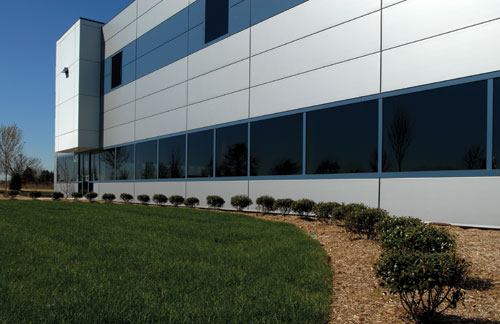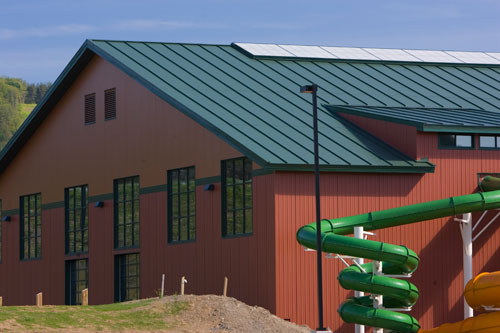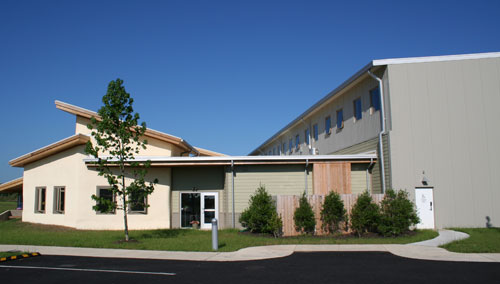Innovative Metal Solutions for the Built Environment
IMPs are available in many finishes and coatings, prefinished on the interior and exterior faces. Coatings provide protection against UV rays, corrosion, humidity, acid rain, chemicals, and pollutants; resistance to chalking, fading, chipping and dirt, and offer gloss retention.
Cool roofs help mitigate global warming and reduce urban heat islands and smog. They reflect (solar reflectance) and radiate (thermal emittance) the sun's heat away from a building. Insulated metal roof panels with a white exterior skin meet the definition of cool roofing for low-slope roofing under the 2005 California Energy Code.
Panel Description and InstallationInsulated metal panels offer installation savings through single element panels and fewer side joints, resulting in weathertight performance. They are self-contained units of roof weather membrane, roof insulation, and liner/decking. Engineered end laps create long runs from roof ridges to eaves. The panel ends are supported by the roof structure.
Architectural Wall PanelsArchitectural wall panels provide a flush appearance, and combine well with window systems. High-performance continuous insulation panels provide air, water, thermal, and vapor protection in a single-panel component without thermal bridges. They are quick and easy to install behind any type of external cladding, such as a single-skin metal panel. The panels are separated from the building interior by an approved thermal barrier. IMPs are tested and carry ratings for fire, structural performance, thermal transmittance, foam core properties, water penetration, and air pressure differential.
 |
ProCLAD, Inc.’s new corporate headquarters in Indianapolis, Indiana, utilized approximately 11,000 square feet of flat insulated metal wall panels finished in silver and blue, accented with horizontal reveals. The 15,000-square-foot building incorporates a window system featuring a flush frame that integrates with the horizontal wall panels. Architect: Lamson and Condon Architecture and Interior Design. Photo courtesy of Metl-Span |
Thermal Performance
IMPs can reduce operating costs by lowering building energy consumption. They are installed completely outboard of a structure. In this way, consistent R-values are maintained across the entire wall and roof areas. The R-value refers to resistance in heat flow and is a measure of thermal resistance, especially regarding insulation. Increasing the thickness of an insulating layer increases the thermal resistance. The higher the R-value, the greater the insulating power.
Insulated metal panels have high insulation values with built-in thermal breaks, impermeable faces and membranes, and concealed fastener systems with vapor, air and water barriers. Panel selection should be based on the thickness needed to meet required thermal value and structural needs. Thermal values should be specified based on local codes, usage, and occupancy. IMPs have a foam core that provides R-values generally ranging from 15 to 48 as tested with ASTM C1363 at 75 F, in thicknesses from 2 to 6 inches for wall systems, and R-values ranging from 10 to 48 for roof systems.
RatingsPanel production must formulate a foam system with the right balance of the following properties: shear, tensile and compressive strength; humid, heat and cold aging; density, flash and ignition properties.
Structural load capacity should be tested for positive and negative wind loads by an independent testing agency. The panel manufacturer should verify testing data to ensure that panel structural capacity meets project requirements. Coatings are tested and rated for various conditions, including color change, chalk resistance, specular gloss, humidity, salt spray, impact and abrasion resistance.
Design BenefitsInsulated metal panels offer flexibility and design options through a wide range of colors, finishes, and textures. Flat, profiled, curved and formed panels may be installed horizontally or vertically. A flush appearance can be achieved when panels are attached with concealed clips and fasteners in the side joint, often ideal for high-profile applications.
Insulated Metal Panels Case Studies
| 1. Hope Lake Lodge Cortland, New York LEED Silver Architect: RBA Group |
||
A new indoor water park at the Greek Peak Ski Center transformed the winter resort into a year-round destination. The temperature inside the 28,000-square-foot facility is maintained at 80-84 degrees F even during the most frigid months. Approximately 60,000 square feet of insulated metal panels were used to clad the roof and walls. A steel structure enabled the use of large clear spans of IMPs to house the water park features and provides high thermal efficiency. To address the inherent high humidity and chlorine-laden atmosphere, steel members were galvanized and powder coated for corrosion-resistance. |
| 2. Aerzen USA Coatesville, Pennsylvania LEED Gold Architect: Re: Vision Architecture |
||
The Aerzen USA plant is an environmentally friendly facility that manufactures industrial equipment. Approximately 54,000 square feet of insulated metal panels were used on the wall and roof. A lightly corrugated panel profile on both faces ensures symmetry from the outside to inside. IMPs usually used for freezer applications quadrupled the insulation value. |











